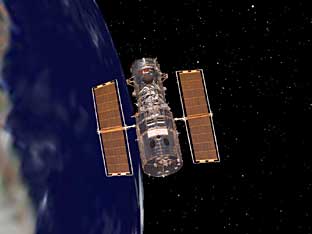

 |
|
Starry Night Gallery |
||
 |
 |
 |
| The Sun’s new baby: artist’s conception of Asteroid (plutino) 2000 EB173, October 28, 2000 |
The International Space Station, “Alpha,” as of October 2000 |
Phobos & Deimos from 442 km above Mars, 2:00:00 UTC, May 20, 2000. FOV 30’. |
 |
 |
 |
| Apollo 11 Lunar Ascent Module and sky, from Command Module (LM and moon surface from NASA photo) |
Space Station One, from 2000: A Space Odyssey, over the coast of Africa November 5, 2000, 5:10:00 UTC |
The Chandra X-Ray Observatory, 18:00:00 UTC, November 13, 2000, 4X binoculars |
 |
 |
 |
| The RMS Titanic and the sky five minutes before the ship struck the iceberg (image credits) |
Saturn, from 167 km above its satellite Mimas, at 14:00 UTC, November 1, 2000 |
Ptolemy’s Rosette: A thing of beauty (Click for explanation) |
| Starry Night is fun, but it’s also a serious astronomy tool. The Pro version can drive any of several different telescopes. Its "LiveSky" feature allows you to attach documents, images, and even Web sites to any celestial object. And it’s being used by SETI, the Search for Extra-Terrestrial Intelligence. Starry Night Beginner knows about 100,000 objects. Starry Night Backyard ups the ante to over a million objects, and Starry Night Pro’s database contains a catalog of 70,000 galaxies as well as the complete Messier, NGC/IC, SAO, Hipparcos/Tycho and Hubble catalogs. (Yes, all 19 million Hubble objects!) With Starry Night Pro, you can download deep-sky images directly from the Digitized Sky Survey into Starry Night. You can also download and add specialized databases, such as one containing the stars with known planets.
’Nuff said? To learn much more about Starry Night, visit SPACE.com. There are other sites on the World Wide Web where you can view Starry Night images; just search for "Starry Night". There’s even a site where you can download add-ons for Starry Night. |
| Maps of the Solar System. This is where I found many of the planetary surface images I use with Starry Night. Excellent site, with links to sites containing other images. | |
| Revised surface maps of Earth with atmosphere and without atmosphere for Starry Night. Revised 1/8/2001, better cloud mapping and improved color realism! Both maps are now 2048x1024 pixels in size. To work around a bug in Starry Night, you might need to rename these images to Earth_atmos.pct and Earth.pct. | |
| Starry Night, by Bill Arnett. Add-ons for Starry Night, including databases of selected objects (such as the galaxies in the Local Group or Dr. David Green’s Galactic Supernova Remnant catalog). Bill also maintains an excellent site full of astronomical information. | |
| LiveSky, the companion site for Starry Night, by SPACE.com Canada. A good site with a great deal of astronomical information and links to more. The Starry Night programs have a direct link to this site; bring up the info window for an object, and click to go to LiveSky for more. | |
| Amateur Astronomy, by John Rummel. A nice compact hobbyist’s site, with some good articles and some of John’s own photos of deep-sky objects. You might recognize his starry background; he’s using my image. | |
| My spacecraft images for Starry Night. I have several sets available, with five spacecraft in each set. NEW! Set 4 ncludes the latest ISS (“Alpha”) configuration as of 10/2000! | |
| Astronomy isn’t my only hobby. I also collect, repair and sell fountain pens. |
|
|